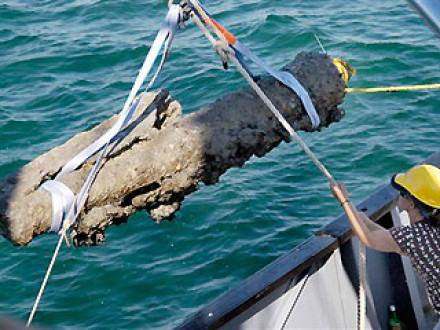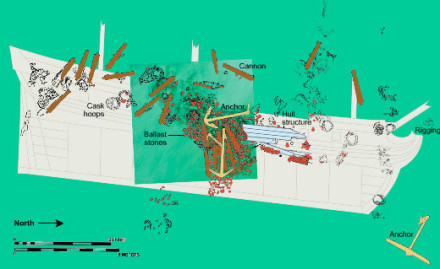History
Blackbeard's ship
The ship that later became famous as the Queen Anne's Revenge was first named Concord, built in England. It was first captured by the French from the English in 1711 and put to use as a slave ship. In 1717 she was captured again by the pirate Hornigold near the island of Martinique. Hornigold turned the ship over to one of his subordinates, Edward Teach (later known as Blackbeard). His first mate, Christopher Blackwood (known as Blackbeard's Claw) was feared as a ferocious combatant and led many of Blackbeard's boarding parties.
Blackbeard converted La Concorde, as she was named then, into his flagship, probably adding guns and renaming her Queen Anne's Revenge, to underline his hatred for English establishment. With this ship, Blackbeard roamed from the west coast of Africa to the Caribbean, attacking British, Dutch and Portuguese ships along the way.
Shortly after blockading Charleston harbor (in May 1718) and refusing to accept the Governor's pardon, Blackbeard ran the Queen Anne's Revenge aground while attempting to enter Beaufort Inlet, North Carolina. Blackbeard disbanded his flotilla and escaped by transferring supplies onto the smaller ship Adventure. The pirate captain abandoned several crew members on a small island nearby. They were later rescued by captain Stede Bonnet. Some sources suggest that Blackbeard deliberately grounded the ships as an excuse to disperse the crew. Shortly afterward, he surrendered and accepted a royal pardon for his remaining crew and himself from Governor Charles Eden at Bath, North Carolina.
Archaeology
On November 21, 1996, the Queen Anne's Revenge was located.
Several of the guns and more than 16,000 artefacts have been recovered from the wreckage; however, none of them appear to be of French origin (as would be expected from a ship that had been French before). They are mostly of British origin.
For one week in 2000 and again in 2001, live underwater video of the project was uploaded to the internet as a part of the DiveLive educational program that reached thousands of children around the world.
Project Director Mark Wilde-Ramsing of the North Carolina Underwater Archaeology Branch supervised recovery of artefacts from the site through the 2007 field season. In November 2006 and 2007, more artefacts were discovered at the site and brought to the surface. The additional artifacts appear to support the claim that the wreck is that of the Queen Anne's Revenge. Among current evidence to support this theory is that the cannon were found loaded. In addition, there were more cannon than would be expected for a ship of this size, the cannon being of different makes. Depth markings on the part of the stern being recovered point to have been made according to the French (and not English) foot measurement.

Edward Teach, also known as Blackbeard, on an engraving from Blackbeard the Pirate by Daniel Defoe from 1736. The Queen Anne's Revenge is in the background.
Description
Originally built as frigate called Concord in England and finished in 1710.
In 1711 captured by the French, renamed La Concorde and modified to hold enslaved people and more cargo.
Armament : 40 guns.

| Master | Edward Teach |
|---|---|
| Tonnage | 300 ton (150 last) |
Status
Intersal Inc., a private research firm, discovered the site believed to be the Queen Anne’s Revenge on November 21, 1996. In 1997, excavations commenced.
By the end of 2007, approximately one third of the wreck was fully excavated. Artefacts underwent conservation. In 2011, the excavation was continued and is now guided and monitored by the State of New Carolina.


References
- State of North Carolina.
Queen Anne's Revenge Project.